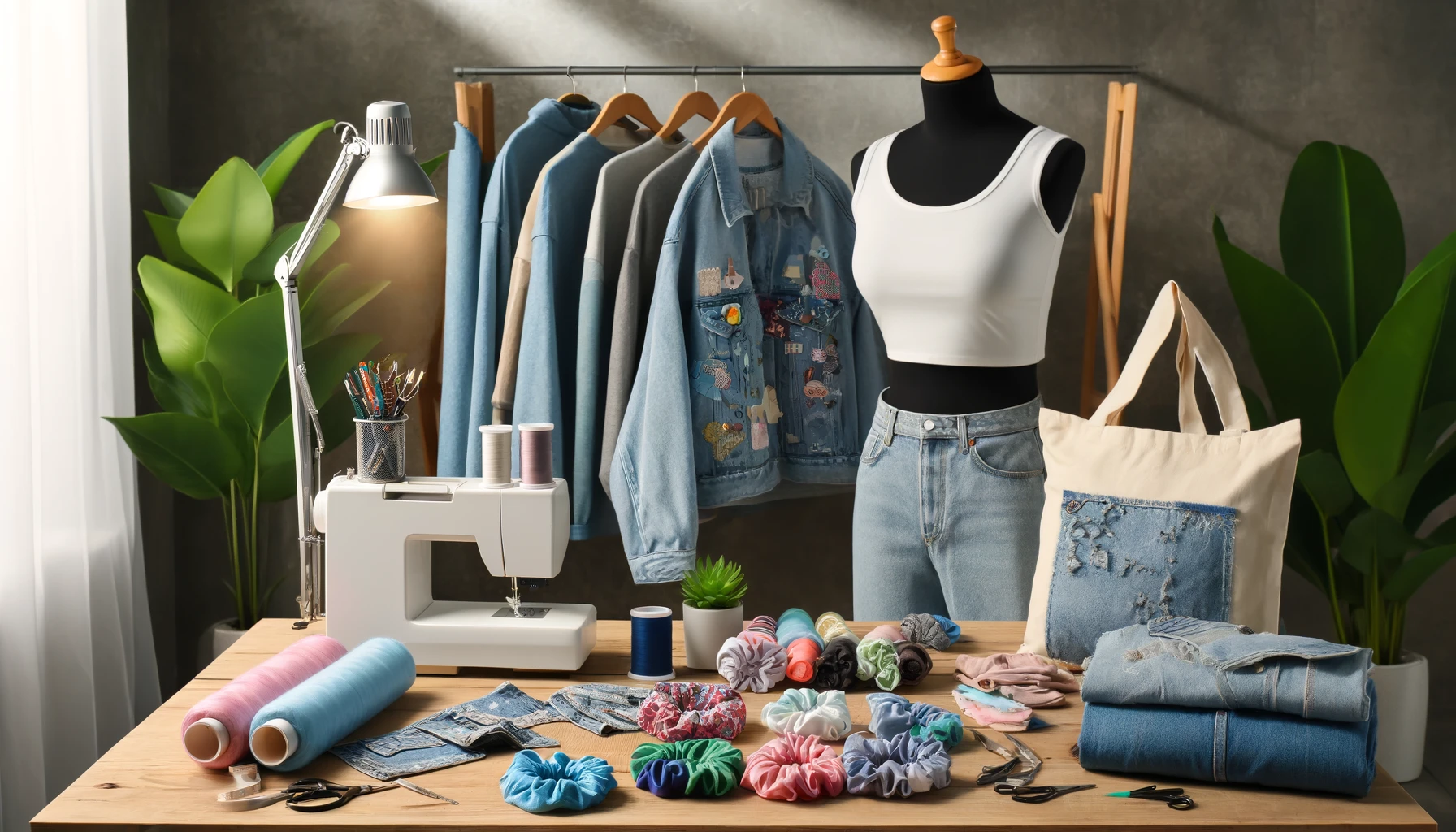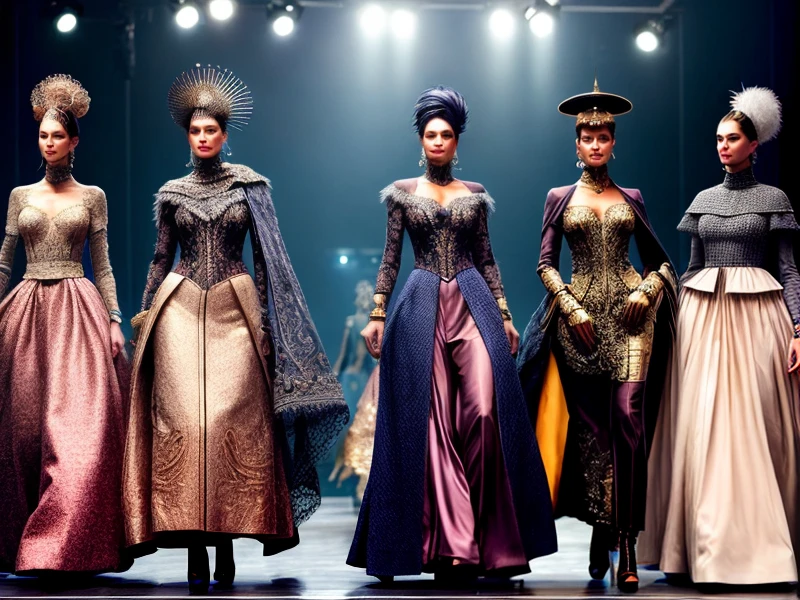DIY Fashion: Transform Old Clothes Into Trendy New Pieces
Are your closets overflowing with clothes you never wear? Instead of letting old garments collect dust, why not give them a new life as stylish pieces? DIY fashion is a fun and creative way to refresh your wardrobe while also saving money and reducing waste. In this blog post, we wiplants_finderplants_finderll share some of our favorite DIY projects to help you get started on this exciting journey. With a little bit of creativity and some basic sewing skills, you can transform outdated clothes into trendy new outfits that truly reflect your personal style. So, let's dive right in!
Benefits Of DIY Fashion
DIY fashion offers several benefits beyond just saving money and reducing waste. It allows you to:
Express Your Creativity: Creating something new from old pieces lets you tap into your artistic side. Whether you're repurposing an old dress or turning a t-shirt into a stylish tote bag, the possibilities are endless.
Customize Clothes to Fit Your Body and Style Preferences: One of the main advantages of DIY fashion is the ability to tailor garments to your specific measurements and style. You can adjust the fit, length, and details to ensure each piece is uniquely yours.
Learn Valuable Sewing and Crafting Skills: Engaging in DIY fashion projects helps you develop practical skills like sewing, hemming, and fabric manipulation. These skills can be handy for future projects and even for basic garment repairs.
Reduce Your Environmental Impact: By reusing materials, you contribute to a more sustainable fashion ecosystem. According to Treehugger, DIY fashion is a great way to reduce textile waste and extend the life of old clothes. This practice helps to minimize the need for fabric production, which can be resource-intensive.
Sustainable fashion is becoming an increasingly important aspect of the fashion industry as it continues to face challenges related to its environmental impact. By repurposing the garments you already have, you can create a more environmentally friendly wardrobe. Additionally, DIY fashion allows you to make informed choices about the clothes you choose to wear, aligning them with your personal values.

DIY Fashion Project Ideas
Ready to get started with your own DIY fashion projects? Here are some ideas to inspire you:
Crop Tops From T-Shirts
Transform an old t-shirt into a trendy crop top by simply cutting off the bottom. This project is perfect for beginners because it requires minimal sewing. You can leave the edges raw for a casual look or hem them for a cleaner finish. For added flair, consider adding embellishments like lace or fabric paint.
Dresses From Skirts
Give an old skirt a new lease on life by turning it into a dress. Simply sew a tank top or camisole to the waistband of the skirt. This project works best with stretchy knit fabrics that provide a comfortable fit. You can also add a belt or sash to cinch the waist and create a more defined silhouette.
Patchwork Denim
Create a unique patchwork effect by sewing patches of denim from old jeans onto a plain denim jacket or pair of shorts. This project allows you to mix and match different shades and textures of denim for a one-of-a-kind piece. You can use fabric glue if sewing isn't your forte, but stitching will ensure the patches stay in place longer.
Scrunchies From Fabric Scraps
Put your leftover fabric scraps to good use by making scrunchies. Scrunchies are not only trendy but also practical for keeping your hair up. This project is a great way to use up small pieces of fabric that might otherwise go to waste. Plus, you can create scrunchies in various colors and patterns to match different outfits.
Tote Bags From T-Shirts
Turn an old t-shirt into a functional tote bag by cutting off the sleeves and bottom, then sewing the sides together. This project is quick and easy, making it perfect for beginners. You can decorate your tote bag with fabric paint, iron-on patches, or even embroidery to make it truly unique. Tote bags are versatile and can be used for shopping, beach trips, or everyday errands.
Tips For Successful DIY Fashion
To ensure your DIY fashion projects turn out great, keep these tips in mind:
Start with Simple Projects: If you're new to DIY fashion, begin with easy projects that require minimal sewing. This will help you build your skills and confidence before moving on to more complex creations.
Choose Fabrics and Materials That Are Easy to Work With: Some fabrics are more challenging to sew than others. For beginners, cotton and knit fabrics are generally easier to handle compared to slippery or stretchy materials.
Measure Carefully and Pin Pieces Together Before Sewing: Accurate measurements are crucial for a good fit. Always measure twice and pin the pieces together before sewing to ensure everything lines up correctly.
Press Seams Flat with an Iron for a Professional Finish: Ironing your seams flat will give your finished garment a polished look. It also makes sewing easier and more precise.
Have Fun and Don’t Be Afraid to Experiment: The beauty of DIY fashion is that there are no rules. It's all about expressing your personal style and having fun with clothes. Don't be afraid to try new techniques and get creative with your projects.
As Vogue notes, "The beauty of DIY fashion is that there are no rules. It's all about expressing your personal style and having fun with clothes." With these tips in mind, you're well on your way to creating fabulous, eco-friendly fashion pieces that are uniquely yours.

Advanced DIY Fashion Projects And Upcycling Techniques
As you gain confidence and skill in DIY fashion, you can start experimenting with more advanced projects that push your creativity further. Upcycling, in particular, is a fantastic way to create unique, stylish pieces from items you might otherwise discard.
Advanced DIY Fashion Projects
Embellished Denim Jackets
Take your denim jacket to the next level by adding embellishments such as studs, embroidery, or fabric patches. This project requires some planning and precision but the results are well worth the effort. Start by sketching your design on paper, then transfer it to the jacket using fabric chalk. Sew or glue on your embellishments, making sure they are securely attached. For embroidery, use a hoop to keep the fabric taut and follow your design with embroidery floss.
Reconstructed Dresses
Transform an old dress into a new, stylish piece by reconstructing its elements. For instance, you can turn a long dress into a midi or mini dress by shortening the hemline. Use the leftover fabric to create ruffles, add a belt, or make a matching headband. If the dress has a high neckline, consider altering it to a V-neck or off-the-shoulder style. Reconstructed dresses are all about customization, allowing you to create a piece that fits your current style perfectly.
Bohemian Kimonos
Convert an oversized shirt or dress into a bohemian kimono. Start by cutting a straight line down the front of the garment and hemming the edges to prevent fraying. Add fringe, lace, or tassels to the sleeves and hem for a boho-chic look. Kimonos are versatile and can be worn over casual or dressy outfits, adding a stylish layer to your ensemble.
Statement Sleeves
Give an old blouse or sweater a modern twist by adding statement sleeves. You can sew on puffed sleeves, bell sleeves, or ruffled sleeves using fabric from another garment or fabric scraps. This project might require intermediate sewing skills, as you'll need to create and attach new sleeve patterns to the existing garment. The result is a unique, fashionable piece that stands out in any wardrobe.
Upcycling Techniques
Patchwork Creations
Patchwork is a popular upcycling technique that involves sewing together pieces of fabric from different garments to create a new, cohesive design. This method is perfect for using up fabric scraps and gives your clothing a distinctive, eclectic look. You can make patchwork skirts, jackets, or even accessories like bags and hats. The key to successful patchwork is planning your design and ensuring all pieces fit together well.
Fabric Dyeing
Breathing new life into faded or stained clothes can be as simple as dyeing them a new color. Natural dyes made from plants, such as beetroot, turmeric, and indigo, are eco-friendly options that produce beautiful results. Before dyeing, ensure your fabric is clean and free from any finishes that might repel dye. Follow the dye instructions carefully, and consider experimenting with tie-dye or ombre techniques for added flair.
Creative Cutting
Sometimes, a simple cut can completely transform a garment. For example, you can turn an old pair of jeans into stylish shorts by cutting off the legs and distressing the hem. Similarly, a long-sleeve shirt can become a trendy sleeveless top. Always start by marking where you want to cut and use sharp scissors to ensure clean edges. Try on the garment after each cut to make sure you're happy with the length and style.
Appliqué and Embroidery
Adding appliqué or embroidery to your clothes can dramatically change their appearance. Appliqué involves sewing fabric shapes onto a garment, while embroidery uses thread to create designs. Both techniques require some patience and skill but offer endless possibilities for personalization. You can use these methods to cover up stains, repair holes, or simply add decorative elements.
Sustainable Fashion Influencers For Inspiration
To further fuel your creativity, look to sustainable fashion influencers who are making waves in the DIY and upcycling community. These influencers share their innovative projects and provide valuable tips and tutorials on how to transform old clothes into stylish new pieces.
Alyssa Beltempo
Alyssa Beltempo is a well-known sustainable fashion influencer who focuses on slow fashion and mindful consumption. Her YouTube channel and blog offer numerous tutorials on upcycling, wardrobe edits, and creating capsule wardrobes. Beltempo's approach emphasizes quality over quantity, encouraging followers to make thoughtful fashion choices.
Kate Sekules
Kate Sekules, the author of "Mend! A Refashioning Manual and Manifesto," is an advocate for visible mending and upcycling. Her work promotes the beauty of repaired and repurposed clothing, challenging the notion that new is always better. Sekules' tutorials and tips inspire her audience to embrace imperfections and view mending as an art form.
Sustainably Chic
Founded by Natalie Kay Smith, Sustainably Chic is a blog and Instagram account dedicated to sustainable fashion and lifestyle. Smith shares DIY fashion projects, ethical brand recommendations, and tips on building a sustainable wardrobe. Her content is both educational and inspiring, making it a valuable resource for anyone interested in eco-friendly fashion.
Fashion Revolution
Fashion Revolution is a global movement dedicated to promoting transparency and sustainability in the fashion industry. Their website and social media platforms feature stories of upcycling, mending, and sustainable fashion practices from around the world. Fashion Revolution's resources and campaigns, such as #Haulternative, encourage consumers to rethink their relationship with fashion and embrace more sustainable habits.
Eco-Friendly Care And Maintenance For Your DIY Creations
You've invested time and creativity into transforming old clothes into stylish new pieces, and now it's essential to maintain them to ensure they last. Proper care and maintenance can extend the lifespan of your DIY creations, reduce your environmental impact, and keep your wardrobe looking fresh.
Gentle Washing Techniques
One of the most effective ways to care for your clothes is by washing them gently. Harsh washing methods can cause fabric to wear out quickly, fade colors, and lead to damage. Here are some eco-friendly washing tips:
Use Cold Water
Washing clothes in cold water reduces energy consumption and is gentler on fabrics. Cold water helps preserve the color and integrity of the material, making it ideal for both new and upcycled garments.
Opt for a Mild Detergent
Choose a mild, eco-friendly detergent that is free from harsh chemicals and fragrances. These detergents are less likely to cause skin irritation and are better for the environment. Brands like Seventh Generation and Ecover offer sustainable options.
Hand Wash When Possible
For delicate or intricately crafted DIY pieces, hand washing is the best option. Fill a basin with cold water and add a small amount of mild detergent. Gently agitate the garment and let it soak for a few minutes before rinsing thoroughly. Avoid wringing out the fabric to prevent stretching.
Use a Gentle Cycle
If hand washing is not feasible, use your washing machine's gentle or delicate cycle. Place garments in a mesh laundry bag to protect them from snagging or twisting during the wash.
Air Drying Over Machine Drying
Air drying is not only better for the environment but also helps preserve the quality of your clothes. The heat from machine dryers can cause fabrics to shrink, fade, and weaken over time. Here are some tips for air drying:
Hang Clothes to Dry
Use a clothesline or drying rack to hang your garments. For items that may lose their shape, like sweaters, lay them flat on a clean towel to dry. Avoid direct sunlight for colored fabrics to prevent fading.
Indoor Drying Options
If outdoor drying is not an option, set up a drying rack indoors near a well-ventilated area. Ceiling fans or open windows can help speed up the drying process.
Avoid Over-Drying
Remove clothes from the drying rack while they are still slightly damp and let them finish drying while hanging or lying flat. This method helps reduce wrinkles and makes ironing easier if needed.
Proper Storage Solutions
Storing your clothes properly can prevent damage and extend their lifespan. Here are some storage tips for your DIY creations:
Fold Heavy Items
Fold heavy garments like sweaters and jeans to prevent them from stretching out of shape. Place them in a drawer or on a shelf rather than hanging them.
Use Padded Hangers
For delicate items or those prone to losing their shape, use padded hangers. These hangers provide extra support and help maintain the garment's structure.
Keep Away from Direct Sunlight
Store clothes in a cool, dark place away from direct sunlight to prevent fading. Use breathable garment bags for pieces that need extra protection, like dresses or tailored jackets.
Avoid Overcrowding
Give your clothes enough space to breathe by avoiding overcrowding in your closet. Overcrowded closets can lead to wrinkles, fabric distortion, and difficulty finding items.
Repair And Mend
Part of the beauty of DIY fashion is the ability to repair and mend your creations as needed. Embracing visible mending not only prolongs the life of your clothes but also adds unique character to them. Here are some mending techniques:
Patch Holes and Tears
Use fabric patches to cover holes and tears in your garments. You can sew or iron them on, depending on the material and the patch's adhesive backing. Choose patches that complement or contrast with the fabric for a creative touch.
Darn Knitted Items
Darning is a traditional technique used to repair holes in knitted fabrics. Use a darning needle and matching or contrasting yarn to weave a new section of fabric over the hole. This method works well for sweaters, socks, and other knitwear.
Replace Buttons and Zippers
Don't discard a garment just because it's missing a button or has a broken zipper. Replacing these small components is relatively easy and can give new life to your clothes. Keep a small sewing kit on hand with various buttons, zippers, and thread colors.
Eco-Friendly Resources And Communities
To further support your journey in DIY fashion and sustainable clothing care, consider exploring resources and communities dedicated to these practices:
Sustainable Fashion Forum
The Sustainable Fashion Forum offers a wealth of information on sustainable fashion practices, including garment care tips. Their website features articles, guides, and community discussions to help you stay informed and inspired.
Upcycling Blogs and Influencers
Follow blogs and influencers who specialize in upcycling and DIY fashion. They often share tutorials, project ideas, and tips on caring for handmade garments.
Online Sewing Communities
Join online sewing communities, such as those on Reddit or Facebook, to connect with like-minded individuals. These communities are excellent places to seek advice, share your projects, and learn from others' experiences.
Fashion Revolution
Fashion Revolution is a global movement that advocates for transparency and sustainability in the fashion industry. Their website provides resources on upcycling, mending, and sustainable fashion practices, making it a valuable tool for eco-conscious fashion enthusiasts.
Transform Your Wardrobe: Embrace DIY Fashion For A Sustainable Style
DIY fashion is a fantastic way to breathe new life into old clothes, create unique, stylish pieces, and contribute to a more sustainable fashion industry. By embracing the benefits of DIY fashion, exploring various project ideas, and following eco-friendly care and maintenance practices, you can transform your wardrobe and reduce textile waste.
Remember, the journey to eco-chic fashion is all about creativity, experimentation, and mindful consumption. So dig through your closets, gather your crafting supplies, and start your next DIY fashion project. Your new favorite outfit is just a DIY project away, and with each creation, you're making a positive impact on the environment. Happy crafting!
Latest news

A Brief History of Fashion: From Ancient Times to Modern Trends

Runway Rundown: Exploring the Latest Fashion Trends

Style Seekers, Rejoice! Top Fashion Hotspots to Visit in 2024

The Second Life of Things: How to Turn Old into New to Look Luxurious

Effective Multi-Factor Authentication Strategies for Safe Online Shopping

